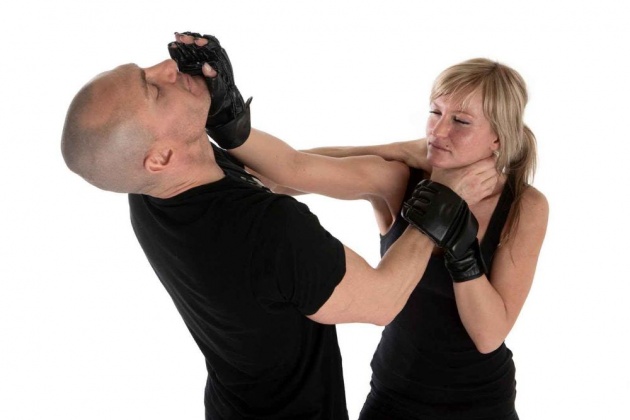First, remember that prevention is the best self-defense. Attackers, whatever their objectives, are looking for unsuspecting, vulnerable targets. So be sure to follow general safety tips like being aware of your surroundings, only walking and parking in well-lit areas, keeping your keys in hand as you approach your door or car, varying your route and times of travel, and otherpersonal security precautions.
Apart from avoiding confrontation, if you can defuse a situation (talk someone down from physically assaulting you) or get away—by handing over your wallet/purse or whatever they want, do that. Hand over your money rather than fight. Nothing you own is worth more than your life or health.
If violence is unavoidable, however, to really defend yourself, you'll want to know ahead of time how to fight back effectively—it's possible even against someone bigger or stronger than you. Here are some basic self-defense techniques that can keep you safe:
As soon as the attacker touches you or it's clear that escape isn't possible, shout loudly ("BACK OFF!") and push back at him or her (for simplicity's sake we're going to use "him" for the rest of the article, although your opponent could be female). This does two things: it signals for help and it lets the attacker know you're not an easy target. The video at left from Rob Redenbach, a former trainer of Nelson Mandela's bodyguards, shows why this is the first thing you need to do. It may not dissuade all attackers, but getting loud will warn off those that were looking for easy prey.
The Most Effective Body Parts to Hit
When you're in a confrontation, you only have a few seconds and a few moves to try before the fight may be decided. Before an attacker has gained full control of you, you must do everything you can—conserving as much energy as possible—to inflict injury so you can get away. (This is no time to be civil. In a physical confrontation that calls for self-defense, it's hurt or be hurt.) So aim for the parts of the body where you can do the most damage easily: the eyes, nose, ears, neck, groin, knee, and legs.
Su Ericksen, who writes the very helpful Self-Defense for Women website, offers techniques for striking these pressure points so you can defend yourself and get to safety. She writes:
Depending on the position of the attacker and how close he is will determine where you will strike and with what part of your body you will employ. Do not step in closer, say, to strike his nose with your hand, when you can reach his knee with a kick.
When striking a target on the upper half of the body you will use your hand. Effective strikes can be made with the outer edge of your hand in a knife hand position, a palm strike or knuckle blow for softer targets or a tightly curled fist.
Eyes: Gouging, poking, or scratching the attacker's eyes with your fingers or knuckles would be effective, as you can imagine. Besides causing a lot of pain, this should also make your escape easier by at least temporarily interfering with his vision.
Nose: If the attacker is close in front of you, use the heel of your palm to strike up under his nose; throw the whole weight of your body into the move to cause the most pain and force him to loosen his grip on you. If he's behind you, you can strike his nose (from the side or front) with your elbow. Either way, aim for the nasal bones.
Neck: The side of the neck is a bigger target, where both the carotid artery and jugular vein are located. You could possibly temporarily stun your attacker with a knife hand strike (all fingers held straight and tightly together, with thumb tucked and slightly bent at the knuckle) at the side of the neck. (For even more injury, you could thrust your elbow into your assailant's throat while pitching the weight of your body forward. See the Target Focus Training video below.)
Knee: Su says the knee is an ideal self-defense target, vulnerable from every angle and easily kicked without risk of your foot being grabbed. Kick the side of the knee to cause injury or partially incapacitate your attacker. Kicking the front of the knee may cause more injury but is less likely to result in imbalance.




